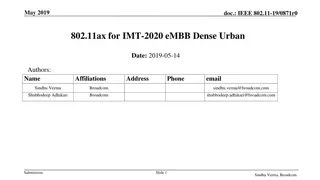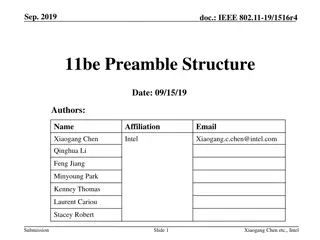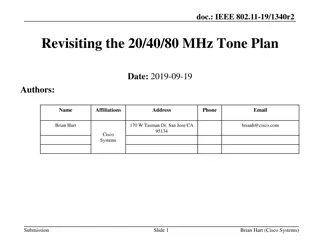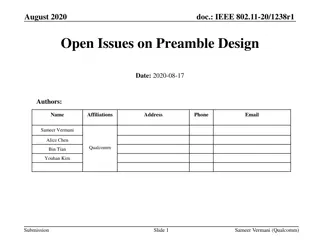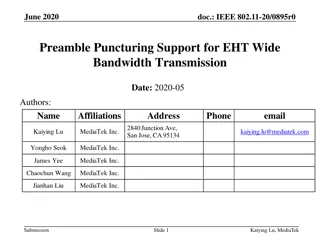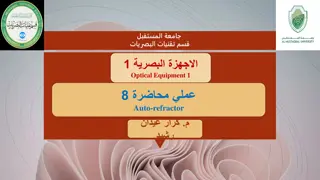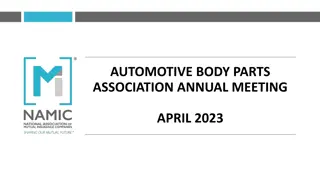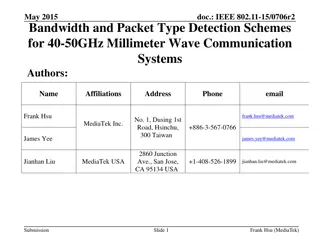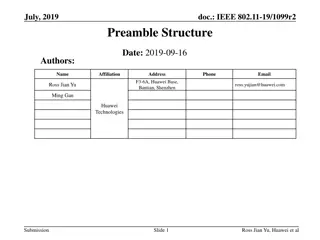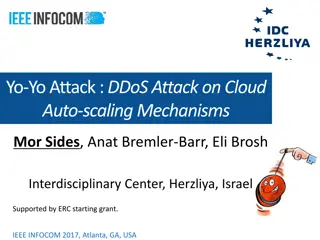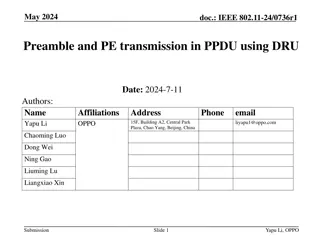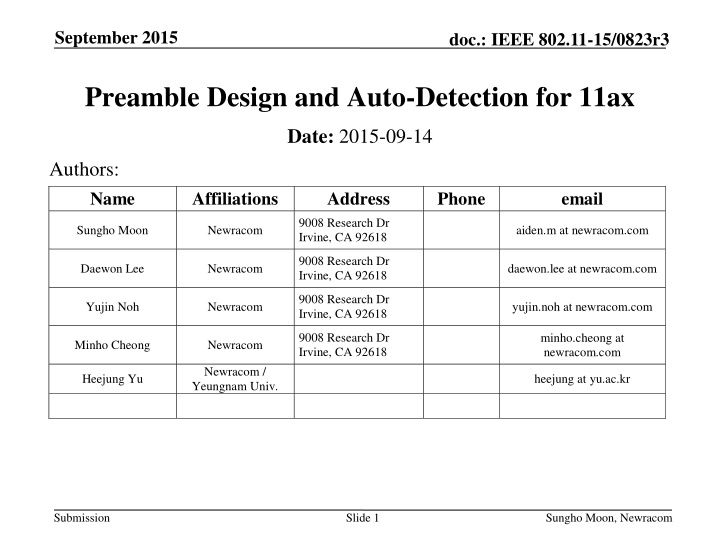
IEEE 802.11-15/0823r3 Preamble Design for 11ax
Explore the design and auto-detection mechanisms for IEEE 802.11-15/0823r3 focusing on preamble design and auto-detection for 11ax. The document evaluates repeated L-SIG and signature symbol schemes, discussing optimization efforts, performance comparisons, and preferences. It delves into modulation techniques, detection algorithms, simulation environments, and detection algorithms specific to 11ax technology.
Download Presentation

Please find below an Image/Link to download the presentation.
The content on the website is provided AS IS for your information and personal use only. It may not be sold, licensed, or shared on other websites without obtaining consent from the author. If you encounter any issues during the download, it is possible that the publisher has removed the file from their server.
You are allowed to download the files provided on this website for personal or commercial use, subject to the condition that they are used lawfully. All files are the property of their respective owners.
The content on the website is provided AS IS for your information and personal use only. It may not be sold, licensed, or shared on other websites without obtaining consent from the author.
E N D
Presentation Transcript
September 2015 doc.: IEEE 802.11-15/0823r3 Preamble Design and Auto-Detection for 11ax Date: 2015-09-14 Authors: Name Affiliations Address Phone email 9008 Research Dr Irvine, CA 92618 Sungho Moon Newracom aiden.m at newracom.com 9008 Research Dr Irvine, CA 92618 Daewon Lee Newracom daewon.lee at newracom.com 9008 Research Dr Irvine, CA 92618 Yujin Noh Newracom yujin.noh at newracom.com 9008 Research Dr Irvine, CA 92618 minho.cheong at newracom.com Minho Cheong Newracom Newracom / Yeungnam Univ. Heejung Yu heejung at yu.ac.kr Submission Slide 1 Sungho Moon, Newracom
September 2015 doc.: IEEE 802.11-15/0823r3 Abstract In the same platform, the previously proposed repeated L-SIG[1] and signature symbol schemes[2] are evaluated The repeated L-SIG scheme needs optimization efforts for repetition threshold considering a trade-off between false detection and mis-detection probabilities The signature symbol scheme shows reasonable performance in both mis-detection and false detection For a simple implementation and future extension, the signature symbol scheme is more preferred than the repeated L-SIG scheme Submission Slide 2 Sungho Moon, Newracom
September 2015 doc.: IEEE 802.11-15/0823r3 Introduction Repeated L-SIG (RL-SIG) [1] Modulating the RL-SIG (L-SIG repetition ) symbol with BPSK and rate BCC. Detection from both a repetition check and an L-SIG validity check Signature symbol (SS) [2] One symbol, MCS 0, separately encoded Signature of 10~12 fixed bits Additional info. of 6~8 bits Detect from checking a known signature after decoding BPSK BPSK BPSK L-SIG 4us R-LSIG 4us HE- SIGA BPSK BPSK BPSK L-SIG 4us HE- SIGA Signature 4us Submission Slide 3 Sungho Moon, Newracom
September 2015 doc.: IEEE 802.11-15/0823r3 Simulation Environments Bandwidth : 20MHz Multi-antenna transmission with CSD: 1x1, 2x1, and 4x1 Wireless channel: TGac D and UMi Carrier frequency offset (CFO): fixed at 40 ppm (@ 5GHz) Phase noise (both at Tx/Rx): -41dBc Real timing estimation & synchronization Signature symbol configuration [2] 12 bits for signature, 6 bits for tail, and 6 bits for random information 11ax detection algorithms Explain in the following pages SIG-A assumption: 34 payload + 6 tail + 8 CRC bits (2 OFDM symbol) Submission Slide 4 Sungho Moon, Newracom
September 2015 doc.: IEEE 802.11-15/0823r3 Detection Algorithm for 11ax : Repeated L-SIG (RL-SIG) Timing/CFO compensation L-STF The same detection algorithm in [1] Repetition threshold, Cross-correlation value btw. L-SIG and RL-SIG L-SIG validity check Parity = OK L-Rate = 6Mbps L-Length (mod 3) = 0 L-LTF Equalization L-SIG Repetition Threshold > N RL-SIG Y MRC & L-SIG Validity Check N Legacy Detection Y t 11ax detect 11n 11ac 11a Submission Slide 5 Sungho Moon, Newracom
September 2015 doc.: IEEE 802.11-15/0823r3 Detection Algorithm for 11ax : Signature Symbol (SS) The same detection algorithm in [2] Signature check After decoding with the tail bits, the 12 bits are matched with the known signature Timing/CFO compensation L-STF L-LTF Equalization L-SIG SIGNATURE N Legacy Detection Signature Check Y t 11n 11ac 11a 11ax detect Submission Slide 6 Sungho Moon, Newracom
September 2015 doc.: IEEE 802.11-15/0823r3 Mis-Detection & False Detection Mis-detection in the 11ax receiver When an 11ax PPDU is transmitted, an 11ax device detects it as other types of PPDUs Two types of false detections Type 1 (to see impacts to legacy devices): When an 11ax PPDU is transmitted, a probability that an 11ac (or 11n) device detects it as an 11ac (or 11n) PPDU It should be checked if a new 11ax PPDU has unusual modulations in the position of 11n/11ac SIG-A symbols Type 2 (to see impacts from legacy PPDUs): When an 11ac (or 11n or 11a) PPDU is transmitted, a probability that an 11ax device detects it as an 11ax PPDU In this contribution, the type 2 false detection is considered. Type 1 false detection has minimal system impact Submission Slide 7 Sungho Moon, Newracom
September 2015 doc.: IEEE 802.11-15/0823r3 Mis-Detection Performance The RL-SIG shows 1.0~1.5 dB gain compared to the SS scheme due to MRC combining of two L-SIG symbols The both schemes shows similar mis-detection curves to each of L-SIG errors 1.5 dB 1.0 dB L-SIG and mis- detection of SS L-SIG and mis- detection of RL-SIG Both schemes show error floors in UMi Submission Slide 8 Sungho Moon, Newracom
September 2015 doc.: IEEE 802.11-15/0823r3 Mis-Detection Performance (cont d) Both schemes show no serious degradation or other noticeable aspects in multi-antenna transmissions Compared to 1x1 in TGac D, the 2x1 has approximately 1.0 dB gain @ 10-1 Compared to 1x1 in UMi, the 4x1 has approximately 1.7dB gain @ 10-1 1.0 dB 1.7 dB Submission Slide 9 Sungho Moon, Newracom
September 2015 doc.: IEEE 802.11-15/0823r3 False Detection for RL-SIG The false detection increases as SNR increases for 11ac/11a PPDUs Even at a high SNR, over 4% of 11ac PPDUs are detected as 11ax PPDU due to the high false detection The same trend is verified in AWGN (Appendix A) 11ac PPDU L-SIG (BPSK) SIG-A1 (BPSK) Correctly Detected as others About 4% false detection 11ax Receiver 11n PPDU L-SIG (BPSK) SIG-A1 (QBPSK) Falsely Detected as 11ax 11a PPDU L-SIG (BPSK) Data (QAM) Most of 11n PPDUs can be filtered out in the repetition check since it has QBPSK symbol Submission Slide 10 Sungho Moon, Newracom
September 2015 doc.: IEEE 802.11-15/0823r3 False Detection for RL-SIG (cont d) In high SNR, 11a/11ac PPDUs are falsely detected as 11ax L-SIG validity check does not work properly in high SNR HE STA combines 11ac L-SIG and VHT-SIG-A1 (in MRC) for decoding If cross-correlation is high enough (according to our simulations, above 0), combined L-SIG + VHT-SIG-A1 successfully decodes as L-SIG. VHT-SIG-A1 is not trellis terminated and acts as interference to L-SIG. If combined second OFDM symbol (e.g. VHT-SIG-A1) is self-decodable (i.e. trellis terminated), the combined signal can be decoded either as L-SIG or the second OFDM symbol. (Appendix B) L-SIG at 0dB (AWGN) can be decoded with 99.7% probability (Appendix C) Submission Slide 11 Sungho Moon, Newracom
September 2015 doc.: IEEE 802.11-15/0823r3 False Detection for RL-SIG (cont d) False detection and mis-detection probabilities trade-off With a large repetition threshold (= tight repetition check), the false detection is reduced But the mis-detection increases (more 11ax PPDUs are filtered out in the repetition check stage) Mis-detection is worse than Non-Combined L-SIG PER Increase with SNR Mis-detection increases with False detection decreases with Submission Slide 12 Sungho Moon, Newracom
September 2015 doc.: IEEE 802.11-15/0823r3 False Detection in the Signature Symbol Good false detection probabilities in both indoor and outdoor channels Always lower than 10-3 (regardless of SNR and PPDU types) False detection that also checks SIG-A CRC is below 10-4 Not seen above 10-4 when SIG-A CRC is checked Not seen above 10-4 when SIG-A CRC is checked Submission Slide 13 Sungho Moon, Newracom
September 2015 doc.: IEEE 802.11-15/0823r3 Additional Simulations for RL-SIG: Repetition Detection with Pre-Equalized Symbols Checking L-SIG repetition using pre-equalized (i.e. before channel equalization) has similar performance. The increases of the false detection is come from the validity check fail, not from the repetition check Still increase with SNR high mis-detection to keep the false detection low Submission Slide 14 Sungho Moon, Newracom
September 2015 doc.: IEEE 802.11-15/0823r3 Additional Simulations in RL-SIG: L-SIG Length Modification in 11ax 11ax transmitter can set the L-Length field which has a modulo-3 of 1 or 2 instead of 0, and 11ax receiver can check it for L-SIG validity It can significantly reduce the false detection probability of 11ac PPDUs The of 0.3 or larger can keep the false detection lower than 10-3 The of 0.3 or larger can keep the mis- detection lower Submission Slide 15 Sungho Moon, Newracom
September 2015 doc.: IEEE 802.11-15/0823r3 Additional Simulations in RL-SIG: L-SIG Length Modification in 11ax (cont d) However, it has still a problem with falsely detecting of 11a as 11ax PPDU. 11a PPDU can be sent with modulo-3 payload length of 1 or 2 and MCS 0 For example) RTS, CTS, and ACK has 20, 14, and 14 bytes which are modulo-3 of 2 Beacon frames will have a modulo-3 of 1 or 2 with a probability of 2/3 Legacy frames of MCS 0 which may be management frames may face detection issue 11ax devices The modulo length changes to L- SIG Length is NOT a fool-spoof solution Submission Slide 16 Sungho Moon, Newracom
September 2015 doc.: IEEE 802.11-15/0823r3 Additional Simulations in RL-SIG: Coverage Gain of RL-SIG After applying an advanced detection algorithm+ for RL-SIG, the false detection can be kept lower than 10-3, but the actual coverage improvement for data frames is non-existent Both RL-SIG and SS have similar performance in Beacon of 150 byte, which is the smallest estimated size* *Note: the conventional (measured) size of Beacon frame is about 300 byte including some optional and vendor-specific features and both schemes has no difference in PER with 300 byte Beacon as well Advanced detection algorithm can make the false detection low at all SNRs Mis-Detection Beacon False-Detection +Note: based on simplified GLRT detection Submission Slide 17 Sungho Moon, Newracom
September 2015 doc.: IEEE 802.11-15/0823r3 Potential Issues in the RL-SIG The false detection probability increases with SNR Worst case: 11ac PPDU or 11a PPDU with BPSK data (e.g. management or control packet) False detection results in loss of 11ac or 11a packet entirely False detection can be mitigated with HE-SIG-A CRC check Results in more complex receiver architecture (due to potential 11n/11ac AGC symbol) Benefits of early detection (right after L-SIG) lost L-SIG Length modification in 11ax can not be a complete solution of the false detection problem L-Length field in 11a PPDUs can have a modulo-3 of 2 especially in RTS, CTS, and ACK Complex receiver architecture & optimization In order to get any MRC gains (from duplication), complex adaptive cross-correlation detection algorithms is needed. Implementation margin is likely to eat up any MRC gain. Submission Slide 18 Sungho Moon, Newracom
September 2015 doc.: IEEE 802.11-15/0823r3 Conclusion Repeated L-SIG scheme, has high false detection probability for 11ac PPDUs and 11a BPSK PPDUs. Extension of repeated L-SIG will be limited and may cause even more miss-detection/false detection issues. With the L-Length modification, most of essential 11a management frames can have the false detection issue 1 dB MRC gain of L-SIG is washed away when taking into account false detection issues. With wrong parameter configuration, even worst performance than single L-SIG decoding Even with use of advanced detection algorithms, coverage gain in data is non-existent Additional one symbol for pure repetition (i.e. RL-SIG) is wasteful Signature symbol scheme is preferred Simple implementation (no additional optimization needed, no additional detection algorithm needed) Robust performance under any scenario Great future extension ability (additional 6~8 bits for 11ax and future use) Slide 19 Submission Sungho Moon, Newracom
September 2015 doc.: IEEE 802.11-15/0823r3 Straw Poll Do you support the following? HE PPDU is with a separately encoded signature symbol immediately after L-SIG. The bitwidth of the signature in the signature symbol is TBD. Submission Slide 20 Sungho Moon, Newracom
September 2015 doc.: IEEE 802.11-15/0823r3 References [1] 11-15-0579r3, Preamble Design and Autodetection [2] 11-15-0643r0, Autodetection with Signature Symbol Submission Slide 21 Sungho Moon, Newracom
September 2015 doc.: IEEE 802.11-15/0823r3 Appendix A: Verification in AWGN False detection prob. (= C/A) As SNR increases, the increase in the false detection can be seen as well in AWGN This increase comes from the L-SIG validity check (See the ratio C/B the next page) Simple bit-level realization of 11ac PPDUs L-SIG(1:24) SIG-A(1:48) Encoding Encoding AWGN AWGN (1:48) (1:48 ) take the first 48 modulated symbol A Repetition Threshold > N B Y Combine two symbols MRC & L-SIG Validity Check N C Y Submission Slide 22 Sungho Moon, Newracom
September 2015 doc.: IEEE 802.11-15/0823r3 Appendix A: Verification in AWGN (cont d) Repetition check pass ratio = B/A It is mostly independent to SNR and varies significantly with value Validity check pass ratio = C/B For all SNRs, it has over 80% pass ratio and increases with an increase in value Submission Slide 23 Sungho Moon, Newracom
September 2015 doc.: IEEE 802.11-15/0823r3 Appendix B: Effect from SIG-A Encoding Assuming the interfered symbol (SIG-A1) is a self-decodable (i.e. trellis terminated within the symbol) (Blue curve), With some chances, the decoding Trellis of the combined signal (L-SIG + SIG-A1) can follow SIG-A1 s because it is also self-decodable However, the current 11a/11ac/11n SIG-A1 is a portion of longer encoded information (Red curve), SIG-A1 is not self-decodable Therefore, highly likely to be decoded as L-SIG and pass the L-SIG validity check Therefore, the L-SIG content check of the combined L-SIG is not useful 50% chance of L-SIG validity check pass Submission Slide 24 Sungho Moon, Newracom
September 2015 doc.: IEEE 802.11-15/0823r3 Appendix C: L-SIG PER in AWGN Approximately 99.7% of L-SIG symbols can be decoded correctly even at 0 dB The 0 dB is almost equivalent to the condition combining an L-SIG symbol with the same powered random symbol without noise Submission Slide 25 Sungho Moon, Newracom




